Introduction
- Alcohol use disorder (AUD), more commonly known as alcoholism, is defined as any health issues (physical or mental) that result from the consumption of alcohol.
- 6.8% of the U.S. population meets the criteria for AUD, but only 8.9% of them received treatment at an appropriate facility (Barata et al., 2017).
- At 88,000 annual deaths, excessive alcohol consumption is “the fourth leading preventable cause of death in the U.S.” (Barata et al., 2017).
Alcohol is widely known to be a harmful substance, but many people tend to underestimate its dangers due to the slow and incremental nature of its effects. Excessive consumption of alcoholic beverages, in both the short and the long term, can lead to a variety of health-related complications. These issues are generally grouped under the name “alcohol use disorder,” or AUD. The condition encompasses alcohol dependence, liver issues such as cirrhosis, and a variety of cancers alongside other conditions that are caused or exacerbated by heavy drinking. Furthermore, excessive alcohol consumption can create other issues, such as drunk driving and a variety of other accidents that result in severe injury or loss of life. Nevertheless, many people continue to drink heavily, whether because they do not realize that their habits are excessive or because they are not concerned about their health or that of others.
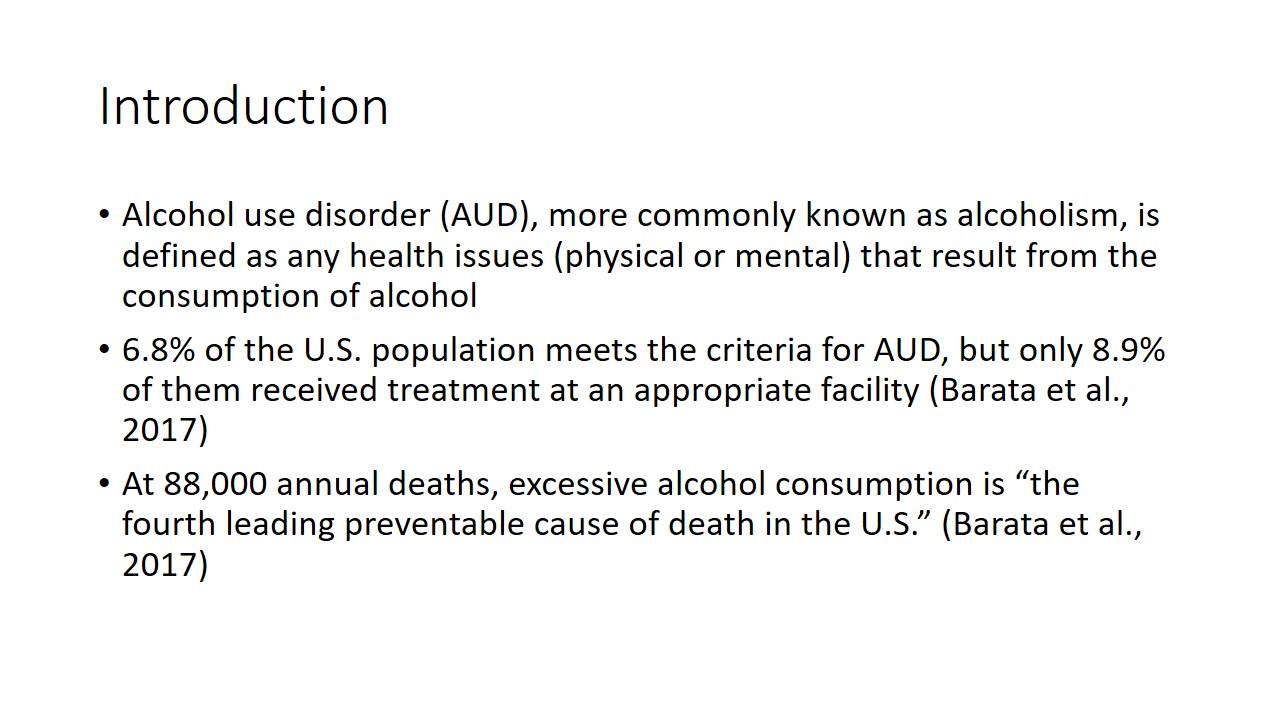
Addiction/Problem Description
- Most adults in the United States consume alcohol regularly (Barata et al., 2017).
- Approximately 679,000 adolescents had an AUD in 2014, but only 8.1% of them receiving treatment at a specialized facility (Barata et al., 2017).
- Miami is a popular resort that has many beaches as well as a prominent nightclub industry.
- Alcohol consumption is naturally high in such an environment, and locals may be drawn into dangerous patterns.
Most people consume alcohol regularly without worrying about the potential dangers of doing so. In most cases, they are correct, but sometimes, they begin relying on it too much or underestimate the potential harm. Barata et al. (2017) claim that 24.7% of adult patients engage in binge drinking, which can lead to a variety of health issues or damaging accidents. Furthermore, minors are in particular danger, as they tend to have worse self-control than adults and are more likely to engage in binge drinking or develop issues. Miami is a famous resort city that is well known for its history of high substance consumption, especially with regards to alcohol. As such, people are more likely to develop an AUD here than in most other locations in the United States.

SBIRT Description
- Pre-screening stage: single questions or small item sets, instruments such as the AUDIT-C test are used (Del Boca, McRee, Vendetti, and Damon, 2017).
- Screening stage: evaluation of disorder likelihood, a variety of tools such as AUDIT and ASSIST are used (Del Boca et al., 2017).
- Brief intervention stage: an explanation of the issue to the patient, identification of reasons behind the habit, suggestion of approaches to resolving the issue (WSU SBIRT, 2019).
- Brief treatment: used for high-risk patients, features individualized therapy sessions with the aim of creating significant behavior change (Del Boca et al., 2017).
- Referral to treatment: transfer of the patient to an appropriate care facility, whether in-patient or out-patient.
The traditional definition of SBIRT consists of three distinct stages: screening, brief intervention, and referral to treatment. However, many care providers add two additional stages into the process, known as pre-screening and brief treatment. Pre-screening is a short procedure used before the screening to identify whether there is a potential issue and what is its nature. The screening goes into more detail and attempts to evaluate the probability that the patient is affected by AUD. There is a multitude of instruments that can be used to evaluate the patient’s alcohol-related habits, and Del Boca et al. (2017) recommend those developed by the WHO, such as AUDIT-C, AUDIT, and ASSIST. After the screening, the brief intervention stage follows, wherein a qualified helper tries to identify the reasons behind the patient’s habit and convince him or her to address them. In the video by WSU SBIRT (2019), the social worker clarifies the reasons why the patient drinks excessively and suggests methods she can use to reduce her alcohol consumption.
Usually, the helper will then redirect the patient to an appropriate care provider in a stage known as referral to treatment. According to Del Boca et al. (2017), the transfers should be ‘warm,’ with seamless transitions, personal introductions between providers, and the provision of transportation and other services, such as childcare, if necessary. There are many different programs available, and the worker should help the patient choose one that is most appropriate for the situation. However, severe cases sometimes require a more careful approach, and so the stage of brief treatment has emerged in some settings. Del Boca (2017) states that federally funded programs require the presence of a brief treatment approach and that it consists of a structured treatment series conducted individually by a licensed counselor, preferably a dedicated SBIRT provider. It should be noted that brief treatment is not a variation of referral to treatment but rather a distinct stage that replaces it in some circumstances.
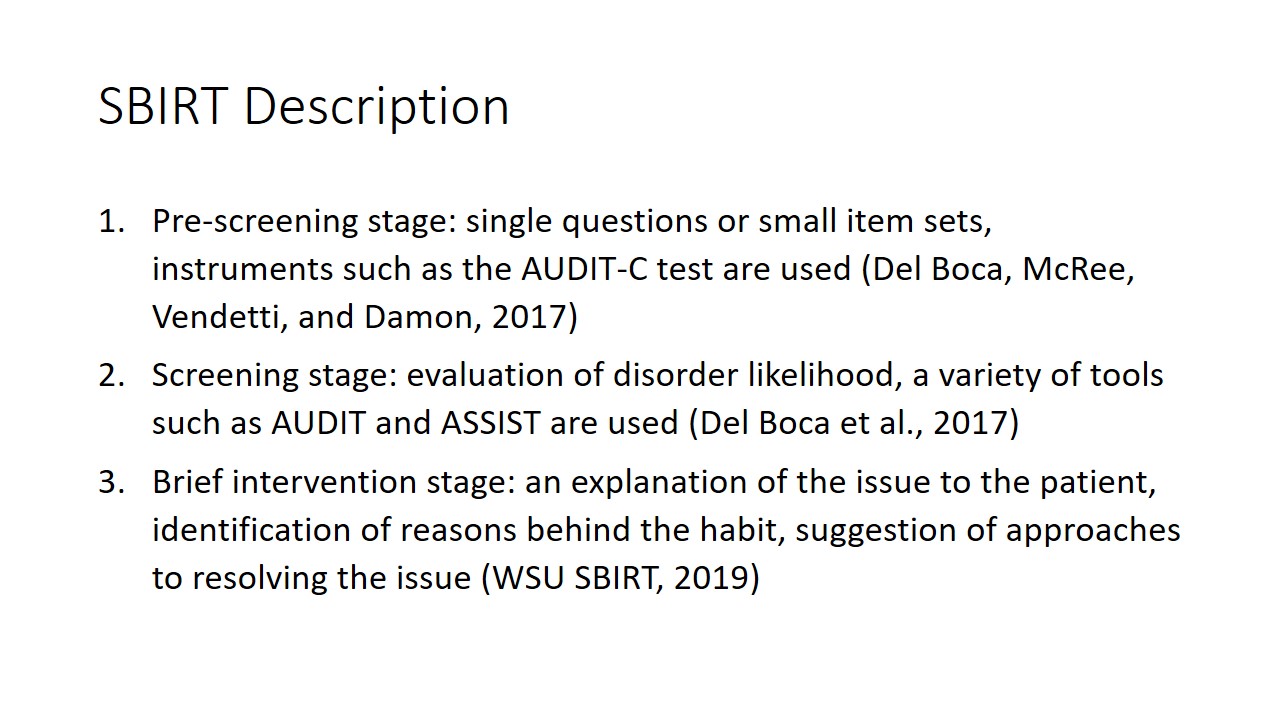
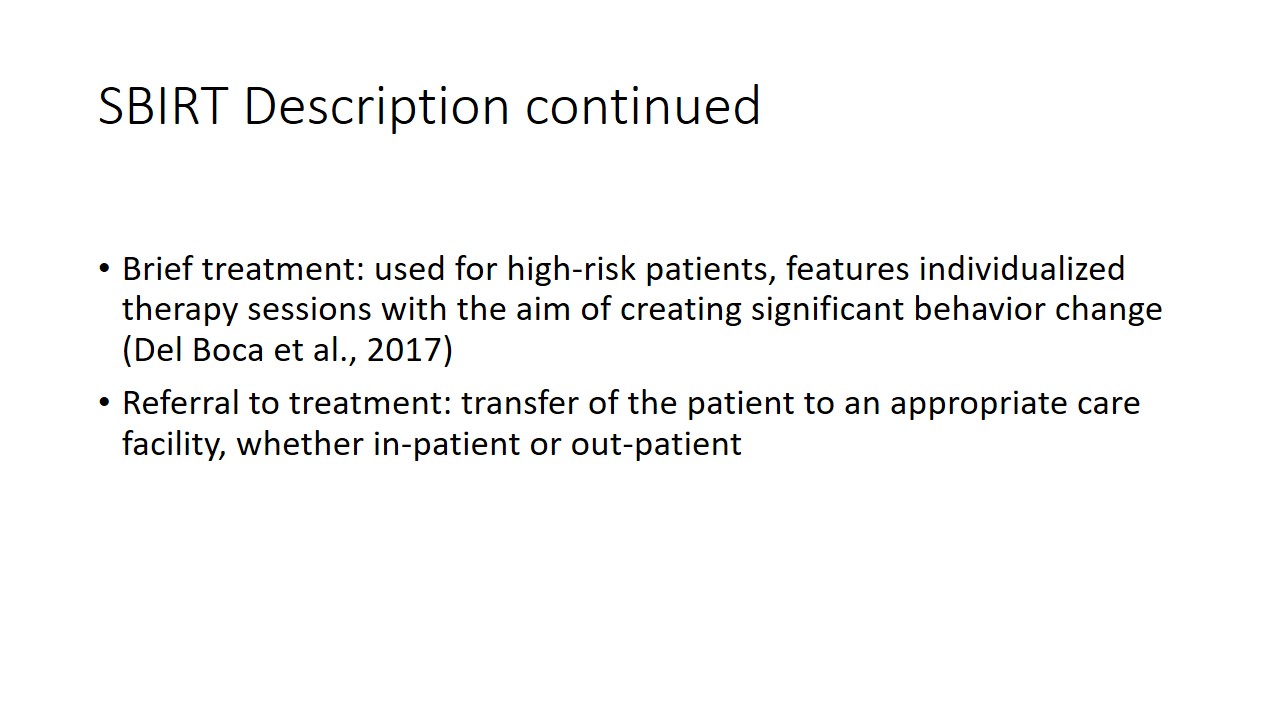
Community Resources
- The Summer House Detox Center, provides patients with a comfortable place to live while they recover from their addiction. It claims a long history of helping patients and careful guidance that prevents withdrawal sickness.
- The United Recovery Project is located in South Florida and features an inpatient alcohol treatment center as well as sober living homes and a partial day program. It has options that should suit most visitors and is ready to help with different conditions as long as the patient is willing.
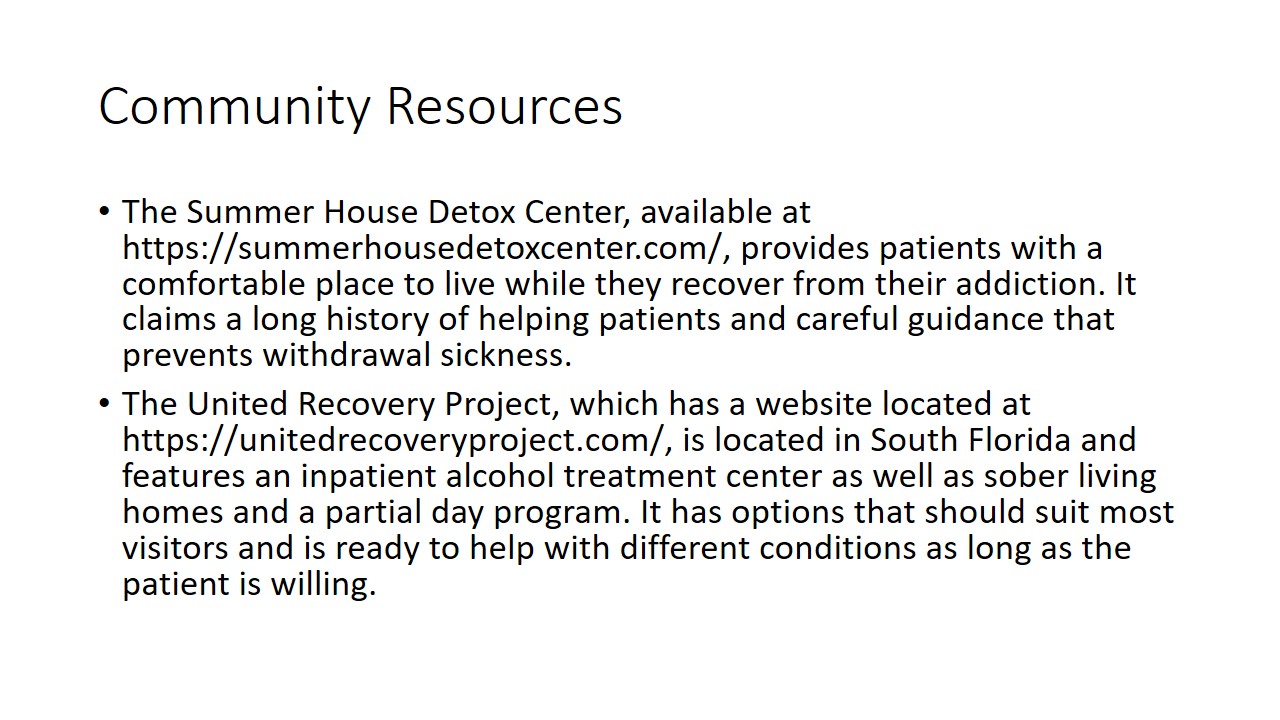
Conclusion and Future Implications for Nursing
- Alcohol use disorder is a prominent concern in the United States, particularly in.
- SBIRT is effective at addressing the issue quickly and efficiently, as most of its stages do not take a long time.
- The process consists of three primary stages, but two additional ones also deserve recognition.
- Pre-screening is used to determine the nature of the potential issue.
- The screening stage is used to determine the probability of an AUD.
- The brief intervention stage teaches the patient to help himself or herself.
- The referral to treatment stage ensures that the patient receives care for his or her issues.
- The brief treatment stage is used for high-risk patients and is required by federally funded programs.
- While SBIRT is effective at addressing alcohol-related issues, many programs and research directions should be expanded due to its evolution.
Alcohol use disorder is a significant issue in *location* as well as the United States as a whole. A considerable part of the issue is the failure of many people to realize the dangers of alcohol and address them accordingly, exacerbated by the number of potential patients with the condition. As such, the SBIRT process is a highly effective method of addressing the issue, as it provides the necessary information to the patient, ensures that he or she receive appropriate treatment, and takes a relatively short time. SBIRT is named after its three principal stages, Screening, Brief Intervention, and Referral to Treatment, but recently two more have emerged as refinements of the process and adjustments that improve the outcome. Pre-screening is one of the two new stages, and it consists of a small number of questions intended to determine the nature of the potential issue if one exists.
Once the worker determines that the patient may have alcohol use disorder, he or she can begin the screening stage to determine the severity of the issue. Then, using the results, he or she can educate the patient about the issue as well as what he or she can do to address it by changing his or her behavior. Next, the patient is referred to treatment, where specialists can help him or her further by providing appropriate therapy or other interventions. However, the alternate brief treatment stage, used for high-risk cases and encompassing a structured individual intervention session by qualified specialists, is gaining popularity, becoming required for federally funded programs. As such, while the SBIRT method is effective at addressing alcohol-related issues and used worldwide, it may be necessary to expand its definition soon to encompass its new parts.
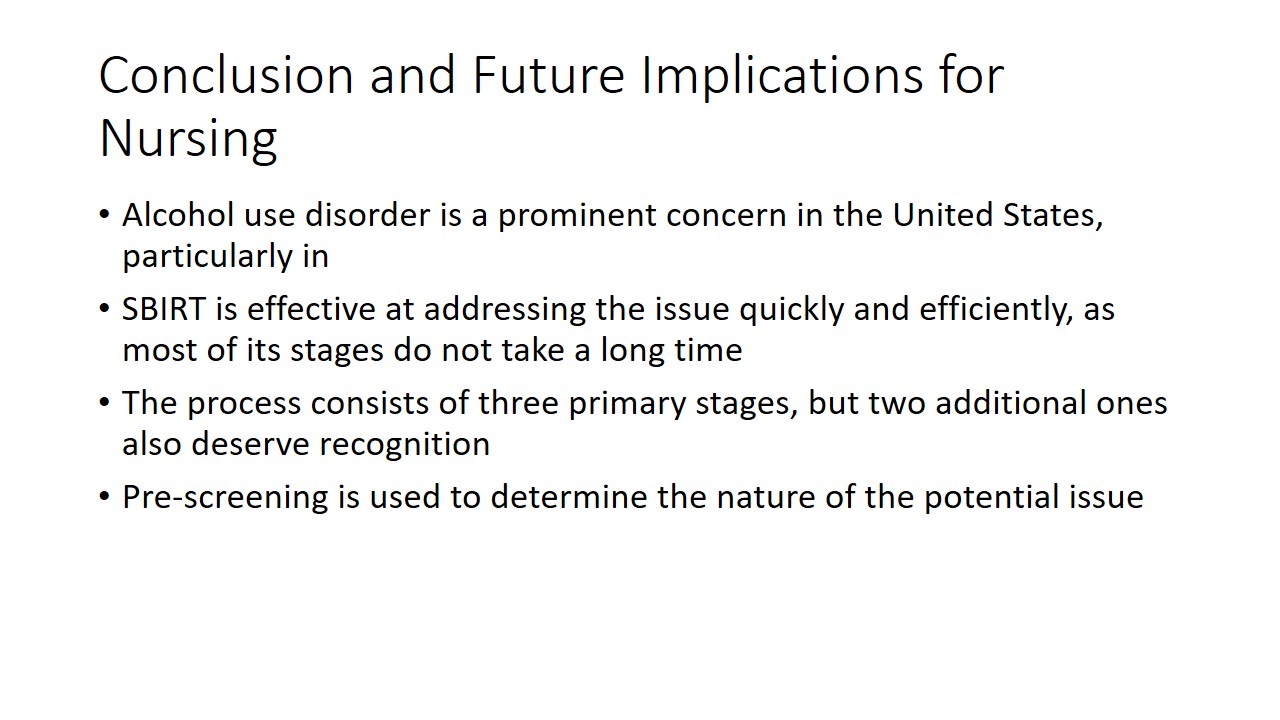
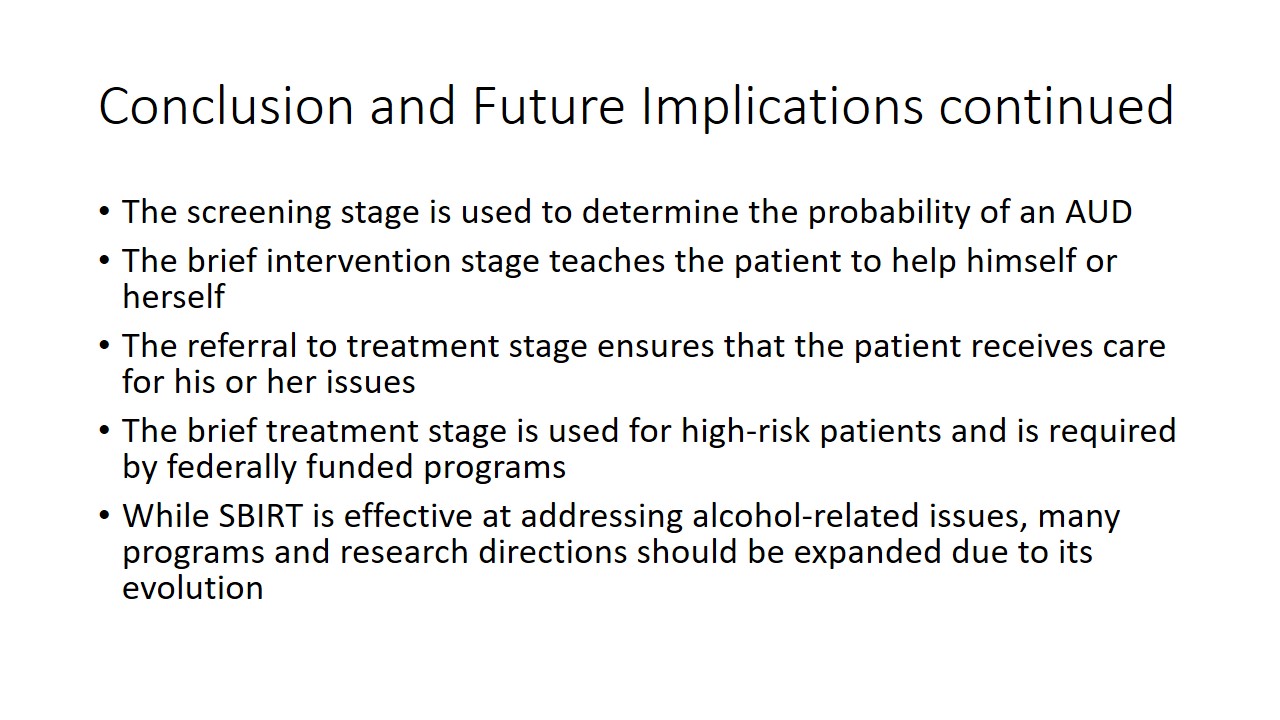
References
Barata, I. A., Shandro, J. R., Montgomery, M., Polansky, R., Sachs, C. J., Duber, H. C., … & Macias-Konstantopoulos, W. (2017). Effectiveness of SBIRT for alcohol use disorders in the emergency department: a systematic review. Western Journal of Emergency Medicine, 18(6), 1143-1152.
Del Boca, F. K., McRee, B., Vendetti, J., & Damon, D. (2017). The SBIRT program matrix: A conceptual framework for program implementation and evaluation. Addiction, 112, 12-22.
WSU SBIRT (2019). SBIRT for Alcohol Use [Video file]. Web.